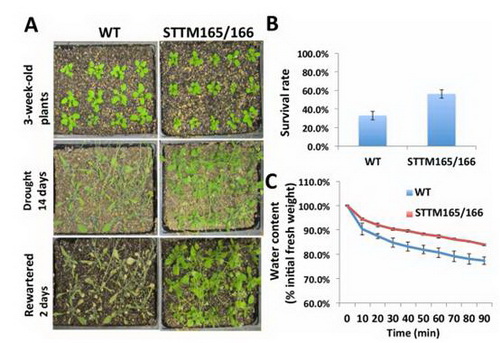PLOS Genetics:中科院逆境中心朱健康研究组揭示miRNA在植物非生物胁
2016年11月3日,国际知名学术期刊《PLOS genetics》发表了中国科学院上海植物逆境生物学研究中心朱健康研究组与其合作者完成的题为“The miR165/166 Mediated Regulatory Module Plays Critical Roles in ABA Homeostasis and Response in Arabidopsis thaliana”的研究论文。该研究揭示了调控植物生长发育的重要调控因子miR165/166在植物干旱、低温胁迫以及ABA响应中的重要作用,为理解miRNA如何调控植物生长发育和非生物胁迫应答提供了重要的理论依据和应用靶点。
micrornA(miRNA)是一种广泛存在于动植物体内的长度为20-24个核苷酸的非编码的小RNA,miRNA在植物的生长发育、逆境反应和养分平衡等生物过程中都发挥了非常重要的调节作用。miR165/166是一个研究最广泛的miRNAs,已被证明参与了植物茎端分生组织、根部顶端分生组织的维持、调控花药和胚珠形态建成、植物韧皮液中的长距离移动与养分平衡的系统性调控等多个方面。然而,miR165/166在植物发育和非生物胁迫响应中的调控和作用机制,目前还知之甚少。
研究人员利用模式植物拟南芥为研究材料,发现了miR165/166对于干旱、低温等非生物胁迫响应以及ABA稳态的维持发挥着极为重要的作用。研究人员发现,在拟南芥种子萌发过程中和萌发后,通过降低miR165/166的表达水平,破坏miR165/166介导的靶标抑制,可导致植物产生干旱和低温耐受表型以及ABA高灵敏度。进一步研究证实, ABA信号转导途径中的转录因子ABI4(abscisic acid-insensitive 4) 作为miR165/166介导通路的下游因子,直接被miR165/166靶标所调控。同时,研究人员还发现,miR165/166表达降低所导致的ABA水平升高,部分是通过miR165/166靶标直接增加了BG1的表达水平,进而将不活跃的ABA转化为活跃的ABA。
研究将miR165/166介导的调控模块与ABA调控网络联系起来,说明了miRNA在ABA响应及内稳态调控中的关键作用;同时也为利用生物技术培育新型抗性农作物提供了新的作用靶点,对进一步培育抗干旱、低温胁迫农作物,解决水资源短缺及低温胁迫引起的农业问题具有重大意义。

原文链接:
The miR165/166 Mediated Regulatory Module Plays Critical Roles in ABA Homeostasis and Response in ArABIdopsis thaliana
原文摘要:
The function of miR165/166 in plant growth and development has been extensively studied, however, its roles in abiotic stress responses remain largely unknown. Here, we report that reduction in the expression of miR165/166 conferred a drought and cold resistance phenotype and hypersensitivity to ABA during seed germination and post-germination seedling development. We further show that the ABA hypersensitive phenotype is associated with a changed transcript abundance of ABA-responsive genes and a higher expression level of ABI4, which can be directly regulated by a miR165/166 target. Additionally, we found that reduction in miR165/166 expression leads to elevated ABA levels, which occurs at least partially through the increased expression of BG1, a gene that is directly regulated by a miR165/166 target. Taken together, our results uncover a novel role for miR165/166 in the regulation of ABA and abiotic stress responses and control of ABA homeostasis.
doi:10.1371/journal.pgen.1006416
作者:朱健康

